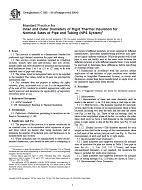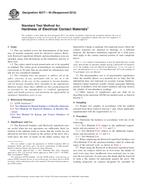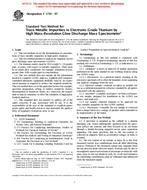1.1 This specification covers two types of chemical admixtures to be added to hydraulic cement concrete mixtures for the purpose of producing flowing concrete. The types are as follows:
1.1.1 Type I – Plasticizing, and
1.1.2 Type II – Plasticizing and retarding.
1.2 This specification stipulates tests of a chemical admixture with reference concreting materials or with concrete-making materials proposed for specific work. Unless otherwise specified by the purchaser, the tests shall be made using reference concreting materials.
1.3 If a chemical admixture has been tested and found to comply with the provisions of this specification using reference materials, and is being considered for use with other materials for specific work, additional tests for such use are allowed if agreed upon between the purchaser and the supplier and are allowed to consist of a portion of the tests described herein.
1.4 This specification provides for three levels of testing.
1.4.1 Level 1 – During the initial approval stage, proof of compliance with the performance requirements defined in demonstrates that the admixture meets the requirements of this specification. Uniformity and equivalence tests of the section on Lot Uniformity and Equivalence shall be carried out to provide results against which later comparisons can be made.
1.4.2 Level 2 – Limited retesting described in the section relating to general requirements may be requested at intervals by the purchaser. Proof of compliance with the requirements of demonstrates continued conformity of the admixture with the requirements of the specification.
1.4.3 Level 3 – For acceptance of a lot or for measuring uniformity within or between lots, when specified by the purchaser, the uniformity and equivalence tests of the section on Lot Uniformity and Equivalence shall be used.
1.5 The values stated in SI units are to be regarded as standard. The values in inch-pound units shown in parentheses are provided for information purposes only.
Note 1 – It is recommended that, whenever practicable, tests be made using the concrete-making materials (cement, pozzolan, slag, aggregates, air-entraining admixture), the mixture proportions, and the batching sequence and other physical conditions proposed for the specific work. The specific effects produced by chemical admixtures may vary with the properties and proportions of the other ingredients of the concrete.
Note 2 – Temperature has a pronounced effect on time of setting of concrete. This may be exaggerated by the use of admixture Types I and II. If concrete temperatures to be expected on a particular job differ significantly from the conditions set forth in this specification, further testing may be desirable.
Note 3 – An unusually rapid loss of workability with time, sometimes termed “slump loss”, can be experienced with these admixtures. The rate of slump loss will vary with the particular concreting materials and proportions, mixing equipment and procedures, and temperatures experienced on any particular job. At elevated temperatures, the slump may be retained for a longer period if a Type II admixture is used.
Note 4 – Admixtures that contain relatively large amounts of chloride may accelerate corrosion of prestressing steel. Compliance with the requirements of this specification does not constitute assurance of acceptability of the admixture for use in prestressed concrete (see ACI 318).
Note 5
Admixtures that contain relatively large amounts of alkali (Na 2O + 0.658 K2O) may contribute to reaction with some aggregates. Compliance with the requirements of this specification does not assure acceptability when used with alkali-reactive aggregates and some cements.
1.6 The text of this standard references notes and footnotes which provide explanatory material. These notes and footnotes (excluding those in tables and figures) shall not be considered as requirements of the standard.
1.7 The following precautionary caveat pertains only to the test method sections of this specification: This standard does not purport to address all of the safety concerns, if any, associated with its use. It is the responsibility of the user of this standard to establish appropriate safety and health practices and determine the applicability of regulatory limitations prior to use.
Product Details
- Published:
- 12/01/2003
- Number of Pages:
- 9
- File Size:
- 1 file , 74 KB
- Redline File Size:
- 2 files , 130 KB


